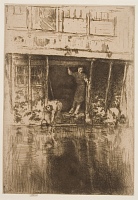Etchings Institutions search term: dowdeswell
The Pierrot | ||
| Number: | 450 | |
| Date: | 1889 | |
| Medium: | etching and drypoint | |
| Size: | 231 x 162 mm | |
| Signed: | butterfly at upper left (6-final) | |
| Inscribed: | no | |
| Set/Publication: | no | |
| No. of States: | 8 | |
| Known impressions: | 33 | |
| Catalogues: | K.407; M.406; W.264 | |
| Impressions taken from this plate (33) | ||
KEYWORD
TITLE
'The Pierrot' (1890, Whistler). 1
'Pierrot' (1890, Whistler). 2
'The Pierrot Amsterdam' (1890, Whistler). 3
'Le pierrot – Amsterdam' (1890, Brussels). 4
'Pierrot The' (1890/1891, Whistler). 5
'Pierrot' (1899, Frederick Wedmore (1844-1921)). 6
The original title was 'The Pierrot' and although it became known for some time as 'The Pierrot, Amsterdam' the original title is preferred.
1: Whistler to R. Dunthorne, 17 February 1890, GUW #13039.
2: Whistler to Dowdeswell's, 6 March 1890, GUW #13804.
3: Whistler to F.A.S, 13 March 1890, GUW #13002.
4: Brussels 1890 (cat. no. 1049).
5: List, [1890/1891], GUW #13236.
6: Wedmore 1899 (cat. no. 264).
DESCRIPTION
SITTER
7: Metropolitan Museum, New York, h2-1998-57.
8: http://gallica.bnf.fr (accessed 2012.07.17); I am deeply grateful to M. Hopkinson for this reference.

r.: Fumette; v.: Dancing clowns [m0289], pencil,
Freer Gallery of Art.
These clowns were copied from a lithograph by Paul Gavarni (1804-1866), 'Nos femm' sont cou-cou' from Impressions de Ménage, 1847. 9
9: Impressions de Ménage, 2nd series, no. 24, 1847.
The character was also appropriated by Symbolist poets, and Whistler, having recently met Stéphane Mallarmé (1842-1898), and being associated both with the French and Belgian Symbolists, may have been responding to their obsession with Pierrot as a tragic, enigmatic figure, distant from reality.
10: The Gentle Art of making etchings, on-line exhibition at http:// etchings.arts.gla.ac.uk
SITE
11: Heijbroek 1997 , pp. 70-71.
12: Mansfield 1909 (cat. no. 406).
DISCUSSION
